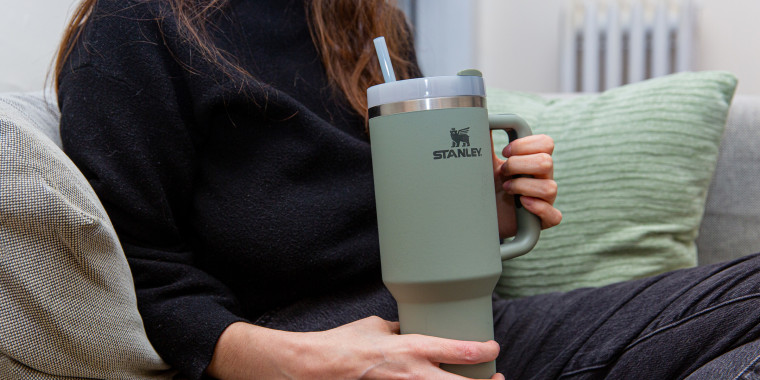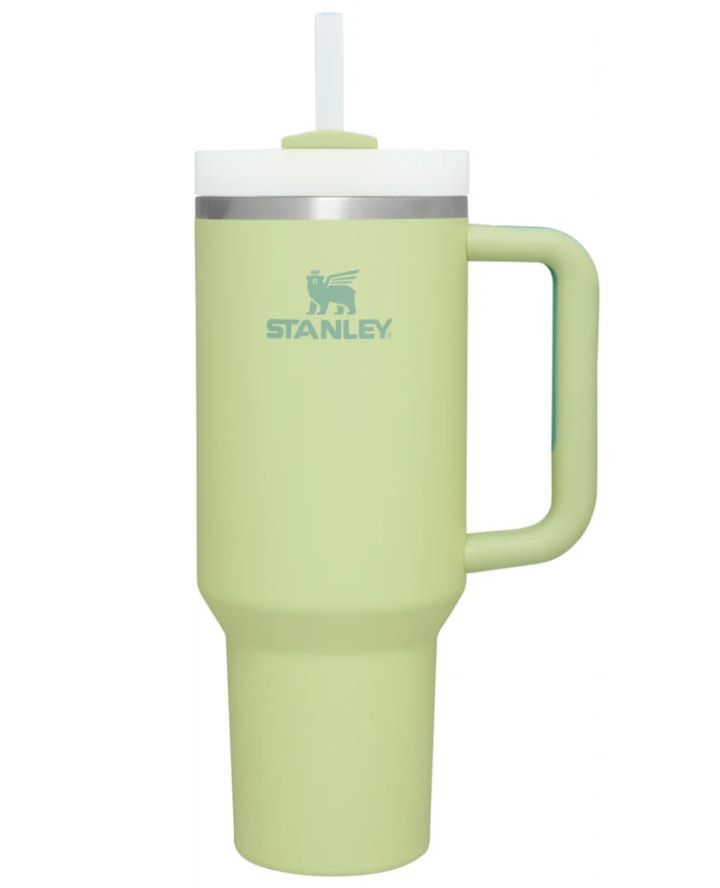The Stanley Quencher has taken water fountains by storm. Known affectionately as “the Stanley cup,” or “the Stanley,” by its fans, the drinking vessel is a vacuum-insulated tumbler that promises to keep your cold drinks cool for hours, keeping you hydrated as you commute, hit the gym or beach, or just sit on the front porch. It’s become a must-have item amongst fitness and wellness influencers and their followers, not only for its impressive volume (40 ounces) and temperature control but also because it comes in a range of delightful colors and patterns. And, despite its size, it fits into a car cup holder, allowing users to stay hydrated and refreshed throughout the day.
LEARN MORE Why people love the Stanley | Is the Stanley worth it? | How much water should you drink in a day?
Stanley Quencher H2.0 FlowState Tumbler (40 ounce)
Beyond the quality of the drinkware (which I’ll get to soon), the Stanley owes a lot of its fame to TikTok, where video reviews of the tumbler garner hundreds of thousands of likes. Further proof of its popularity; it’s entirely out of stock online at Target and only available in a few colors at Walmart and on Stanley’s website (Stanley recently announced that the Tigerlily and Pool colors are soon to be restocked, and fans can sign up to be notified when they’re available for order) . Watching the Stanley’s meteoric over the last few months on social media, and seeing it perched in the crook of many subway riders’ elbows, had me wondering: “Am I drinking enough water? Do I need one of these?'' To see if the vessel might encourage me to drink more water, I lived with the Stanley for a week, carrying it around New York City while full, sipping from its straw while riding the subway and placing it into treadmill cup holders during evening workouts. During this time, I also spoke with dieticians and sports medicine doctors about proper hydration and how much water we need to drink to stay healthy.
Why do people love the Stanley?
If you’re unfamiliar with the tumbler (and its recent social media fame), let me get you caught up. The tumbler is made by the Stanley company, a 110-year-old manufacturer of outdoor gear like coolers and jugs or camping cookware. William Stanley Jr., the company’s founder, was an early pioneer of vacuum insulation technology and patented an early version of a steel vacuum flask. For reference, they looked like this vintage 1970s version for sale on eBay, or something you might find in your grandparents’ garage. Fast forward to today, and that early technology is how the Stanley and comparable vacuum-insulated bottles like the Yeti Rambler or Takeya keep drinks cold.
What I refer to as “the Stanley” is formally the 40-ounce version of the Stanley Quencher H2.0 Flowstate, an upgrade to the original Stanley Adventure Quencher. Fans say they love the Stanley’s ability to keep cold drinks cool and hot drinks warm, its classic, minimalist design, and its tapered bottom that sits comfortably in a cup holder. For many, its straw encourages mindless sipping at one’s desk or in traffic more than a water bottle might. When I used the Stanley, I was really impressed with its temperature control abilities and rotating lid, which minimizes splashes and makes for easy sipping. However, as a city dweller, I found it inconvenient and heavy to carry around, especially when full. As one colleague joked as I placed it on my desk, “that thing is the size of your head.”
Is the Stanley worth it?
Before I cover The Stanley’s features, let me emphasize again: people really want this thing. So much so that some versions of the frequently sold-out $45 cup go for as much as $90 on Amazon. Shopping influencers will often post “restock” videos, alerting their followers of shelves of Stanleys, like this one about the new colorways available at Target. The more I researched Stanley, the clearer it became that for some, the appeal might also be the thrill of the chase, like antiquing, or finding a terrific, but short-lived deal at Costco.
Below, a breakdown of what else makes the Stanley a desirable hydration companion:
- Temperature control: Stanley says its cup keeps drinks cold for up to eleven hours and hot drinks warm for up to seven hours. I filled the Stanley with a couple of ice cubes and cold water and left it overnight. The next day, the ice cubes had melted, but the water was still refreshingly cold.
- Volume: According to the U.S. National Academies of Sciences, Engineering and Medicine, men need about 3.7 liters of fluids a day, or 124 ounces, which is just over three Stanleys. Women need about 2.7 liters or 92 ounces, which is two Stanleys and change. Its 40-ounce volume and vacuum insulation mean hydration is made easier, but its size had a downside for me. When my Stanley was completely filled, I carried it from my house to work, riding the subway and climbing stairs. By the end of my 25-minute commute (relatively short by New York City standards), my wrist wasn’t hurting, but it certainly wasn’t happy. If you plan to keep your Stanley on your desk or in your car cup holder, its weight doesn't matter much. Another option would be to buy the more practical, though less popular, 14-ounce Stanley, which doesn’t have the signature handle.
- Handle: Speaking of handles, I really liked Stanley's ergonomic feel. I was able to comfortably grasp the tumbler with all four fingers up to my knuckles with room to spare, which made schlepping it to and from the water cooler a lot easier. Plus, I won’t lie: it was fun to show off.
- Lid: With some reusable bottles, you have to buy additional lids for various uses. The Stanley solves this problem with its 3-position lid: you can sip through the straw, you can create an opening to drink directly from the lid by rotating its collar, or you can completely close off the top if you don’t want to spill.
- Straw: I found the straw comfortably flexible, and I suspect it encouraged me to mindlessly sip more often throughout the day. Many users also appreciate that this makes it safer to sip from while driving, so your eyes are always on the road.
- Dishwasher-safe: Another perk of the Stanley is that all components of the tumbler (lid, straw and vessel) are dishwasher-safe.
Whether or not the Stanley is the right fit for you depends upon your environment and health needs. If you frequently find yourself thirsty in your car or at your desk and think a sleek water bottle might inspire you to drink more, the Stanley could be a welcome fix (like how a new pair of yoga pants might inspire you to get to the studio). If you consider yourself a “no-nonsense” shopper who wants a quality product, easily, you may not be a good candidate for the massive and hard-to-find Quencher. There are plenty of water bottles that may suit your needs just fine.
Most importantly, Houst-based dietician Samina Qureshi noted that you may want to examine why you’re worried about hydration (and if you need to be). The Stanley is a great product, but it might at best be a fun solution where there wasn’t necessarily a problem in the first place. Consult your doctor, and your pee (more below), if you have additional questions.
How much water should you drink in a day?
From my deep dive into the Stanley on TikTok, I gathered that for most fans, enjoying using the Stanley is the means to better hydration. We might forget to drink even if we’re thirsty during a busy day, but if the Stanley is within view, we might avoid thirst entirely (so goes the logic). And it's good logic. I definitely drank more water when Stanley sat next to my computer mouse, even if I wasn’t dehydrated.
As for hydration, the conventional wisdom used to be to drink eight cups a day, though that has since been called into question. Somewhere along the line, perhaps through the emergence of wellness culture,or fitness influencers and their motivational gallon bottles, a concern about hydration grew. Many people, myself included, wanted to know how much water to drink a day.
The real answer is that there is no perfect number for daily intake. “Every person’s hydration needs are going to vary, depending on the climate, their environment, their activity levels, and their unique health needs,” said Samina Qureshi, a Houston-based registered dietician. The National Academies of Sciences’ recommendation includes all forms of hydration, she added, meaning the fluid absorbed from food like soup, smoothies, or vegetables count toward that goal. If you’re pushing your water intake past the point of desire, advised Qureshi, feel free to stop and ask yourself why you need a certain fluid intake. Where is this pressure coming from, and how can we lessen it?
Dr. James Robinson, a board-certified sports physician at the Hospital for Special Surgery said a quick glance at the toilet is the best way to tell if you’re hydrated or not. “Your urine should be a very pale yellow or even clear,” he said; “If your urine is a dark yellow then you’re probably under hydrated.” Qureshi said when you’re “approaching mustard,” it’s time to take a swig.
As for overhydration, “as long as you have proper kidney function and you do not have heart disease, overhydrating is very unlikely,” said Robinson. The only real risk he sees for overhydration is among athletes doing major endurance events like marathons who may lose too much salt, causing hyponatremia or abnormally low levels of sodium in the bloodstream. The real culprit, according to Robinson, may be “getting too obsessed with the numbers,” he said.
“What I see in my clients who struggle with disordered eating, thoughts and behaviors is that they are doing anything in their means to avoid eating,” said Qureshi. Water intake and resulting appetite suppression hunger, is one way. “To suppress hunger, they will hydrate, hydrate, hydrate to ignore that hunger cue.”
In summary, if you’re thirsty, you should drink. If you’re hungry, you should eat. However, and in what vessel, you do complete those nourishing tasks is your choice. Life is about feeling good.
Catch up on Select's in-depth coverage of personal finance, tech and tools, wellness and more, and follow us on Facebook, Instagram and Twitter to stay up to date.


